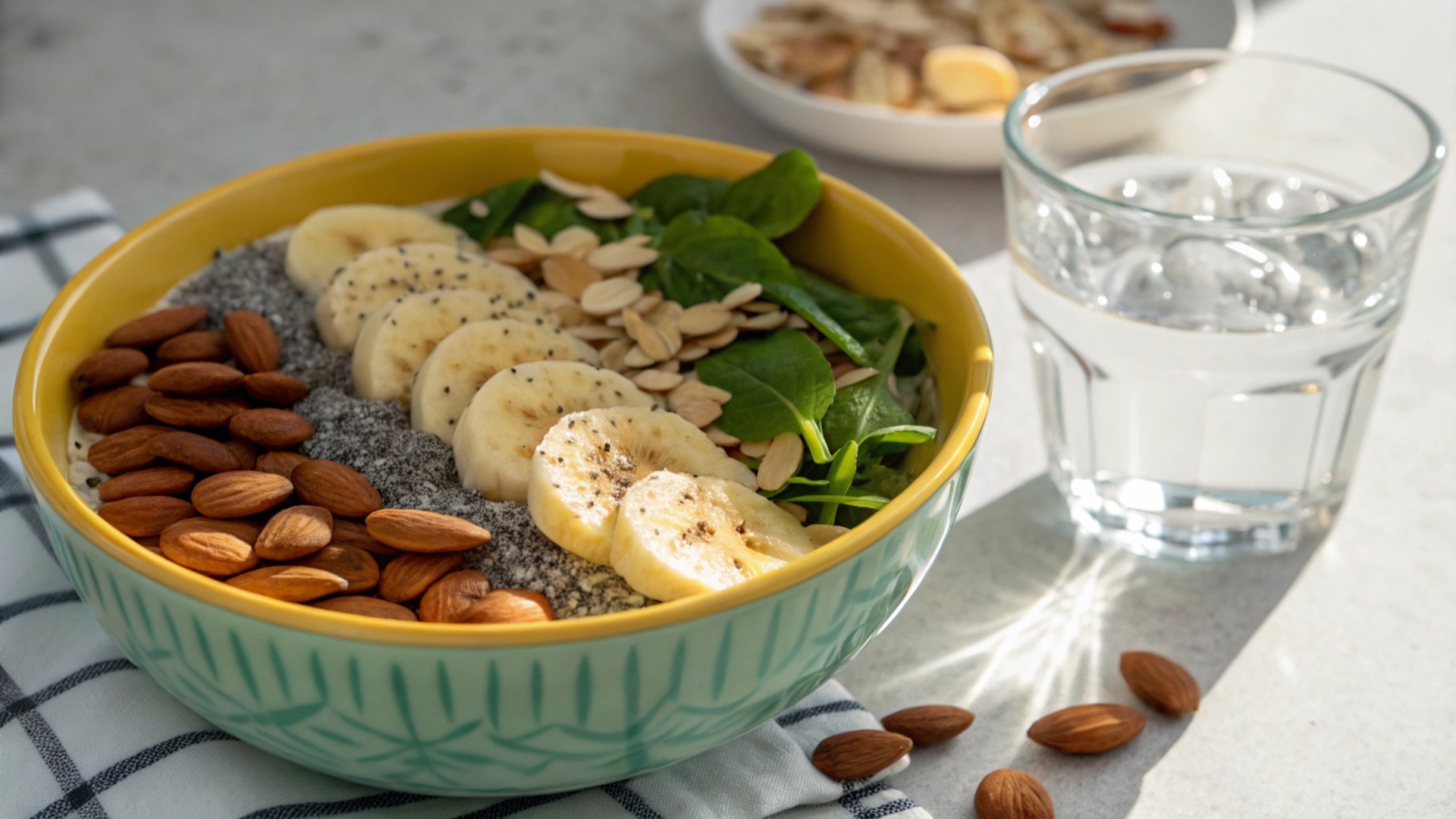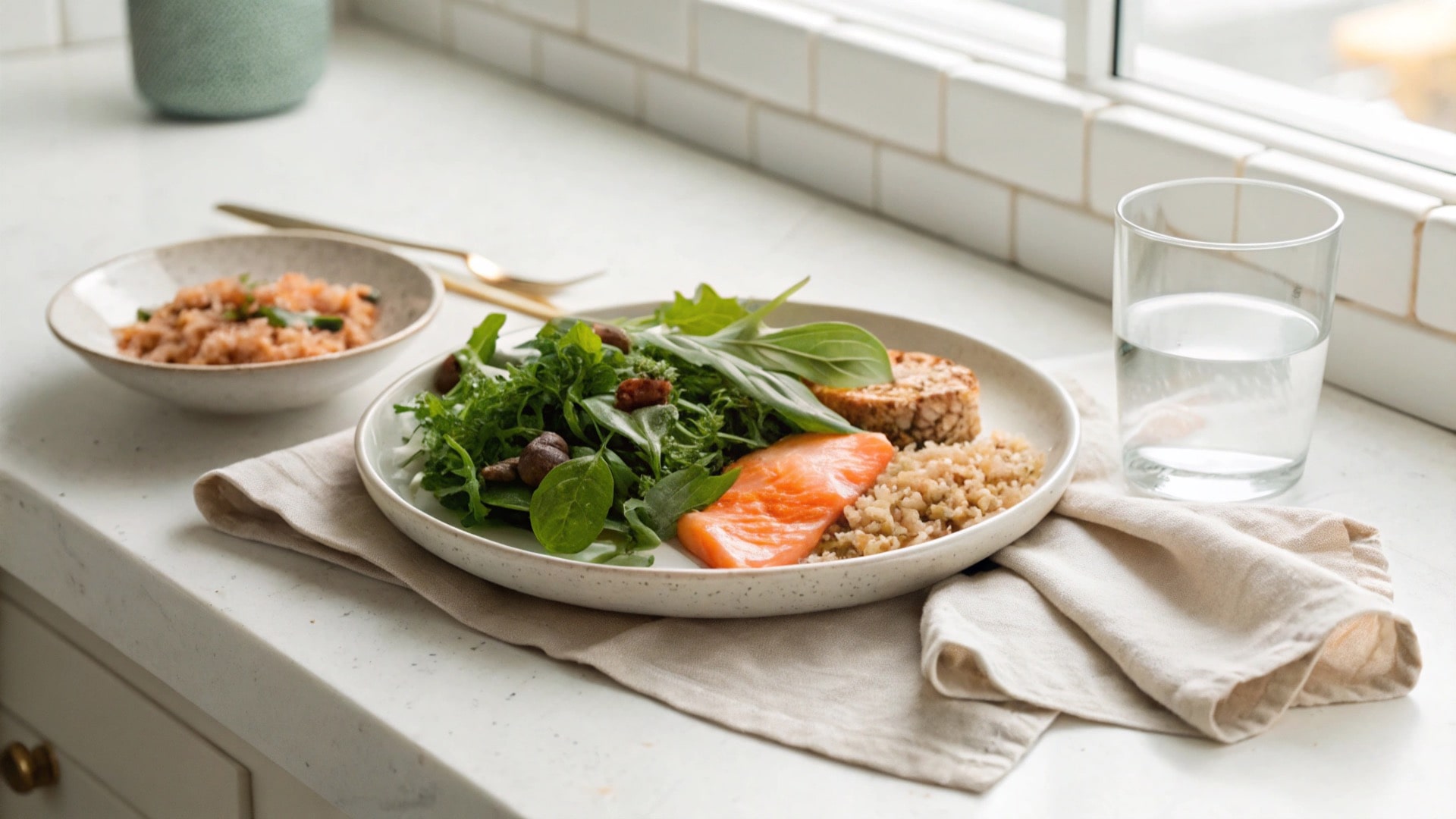Age-related macular degeneration affects millions of people worldwide, but many don’t realize that what they eat can significantly impact their eye health and help prevent or slow the progression of age related eye diseases. If you’re concerned about protecting your vision or have been diagnosed with macular degeneration, you’re probably wondering what foods can help.
Macular degeneration is the leading cause of severe vision loss in people over 50, and many feel helpless against this progressive eye disease. Without proper nutrition, the risk of developing advanced macular degeneration increases dramatically, potentially leading to irreversible vision loss that affects daily activities like reading, driving, and recognizing faces. Research shows that specific foods rich in antioxidants, omega-3 fatty acids, and essential nutrients, as part of a balanced diet, can significantly reduce your risk and slow the progression of macular degeneration while supporting both eye and overall health.
Drawing from extensive research published in leading nutrition and ophthalmology journals, this guide reveals the most effective foods for protecting your macula, supporting overall health, and maintaining healthy vision throughout your life.
Key Takeaways
- Fish consumption reduces macular degeneration risk by 18% when eaten 1-5 times per week
- Leafy green vegetables provide lutein and zeaxanthin, essential carotenoids that act as natural sunglasses for your eyes
- Colorful fruits and vegetables supply antioxidants that combat oxidative stress in retinal tissue
- Nuts and seeds offer vitamin E and healthy fats that support overall eye health
- Limiting alcohol and processed meat is crucial, as high consumption increases macular degeneration risk by 20% and 17% respectively
- Eye friendly foods as part of a balanced diet can help protect against macular degeneration and support long-term eye health
What Is Macular Degeneration?
Age-related macular degeneration (AMD) is a progressive eye disease that affects the macula, the central part of the retina responsible for sharp, detailed vision and crucial for central vision. The macula contains the highest concentration of light-sensitive cells and is essential for activities like reading, driving, and recognizing faces.
AMD occurs when the macula deteriorates due to aging, oxidative stress, and inflammation. There are two main types: dry AMD (more common, progressing slowly) and wet AMD (less common but more severe, involving abnormal blood vessel growth).
The disease affects approximately 200 million people worldwide, with prevalence increasing dramatically with age. By age 80, more than 10% of people have some form of AMD. While genetics play a role, research consistently shows that nutrition significantly influences both the development and progression of this sight-threatening condition.
The Science Behind Nutrition and Eye Health
How Antioxidants Protect Your Vision
The retina is particularly vulnerable to oxidative damage due to high oxygen exposure, intense light exposure, and high concentrations of polyunsaturated fatty acids. Antioxidants work by neutralizing harmful free radicals that can damage retinal cells.
Research published in multiple studies shows that specific antioxidants accumulate in retinal tissue, forming a protective barrier against light-induced damage. The Age-Related Eye Disease Studies (AREDS and AREDS2, ages 55 to 80 years) demonstrated that targeted nutritional supplementation could reduce the risk of advanced AMD by up to 25%.
The Role of Carotenoids in Macular Protection
Lutein and zeaxanthin are carotenoids that naturally concentrate in the macula, where they filter harmful blue light and provide antioxidant protection. Certain carotenoids, especially those with provitamin A activity, are particularly important for supporting vision and reducing the risk of age-related macular degeneration (AMD). These compounds cannot be produced by the human body and must be obtained through diet.
Studies indicate that higher dietary intake of lutein and zeaxanthin correlates with increased macular pigment optical density, which serves as a biomarker for reduced AMD risk. People with the highest consumption of these carotenoids show significantly lower rates of macular degeneration development.
The 7 Best Foods for Macular Degeneration
1. Fatty Fish (Salmon, Mackerel, Sardines)
Why it works: Fatty fish provides omega-3 fatty acids (also known as omega 3s), particularly DHA, which is essential for retinal health and reducing inflammation.
The research: A comprehensive meta-analysis of prospective studies found that fish consumption 1-5 times per week reduced total AMD risk by 18%. Both early and late-stage AMD showed significant risk reduction with regular fish intake.
How to include it: Aim for 2-3 servings per week of fatty fish. Baked salmon, grilled mackerel, or sardines on whole grain toast are excellent options.
2. Dark Leafy Greens (Spinach, Kale, Collard Greens)
Why it works: These vegetables are the richest dietary sources of lutein and zeaxanthin, providing up to 20 mg per serving in cooked spinach. As dark leafy green vegetables, they offer a particularly high concentration of these nutrients.
The research: Studies show that people consuming the highest amounts of leafy greens have a 43% lower risk of developing advanced macular degeneration compared to those with the lowest intake.
How to include it: Steam cooking increases the bioavailability of carotenoids. Add spinach to smoothies, enjoy kale salads, or sauté collard greens with garlic.
3. Colorful Berries (Blueberries, Blackberries, Goji Berries)
Why it works: Berries contain anthocyanins, powerful antioxidants that protect retinal blood vessels and reduce inflammation. These antioxidants may also help protect against diabetic eye disease by reducing oxidative stress and supporting overall eye health.
The research: Anthocyanins have been shown to promote rhodopsin regeneration and protect against light-induced retinal damage in laboratory studies.
How to include it: Fresh or frozen berries work equally well. Add them to yogurt, oatmeal, or enjoy as a healthy snack.
4. Nuts and Seeds (Almonds, Walnuts, Sunflower Seeds)
Why it works: These provide vitamin E, zinc, and healthy fats essential for retinal function and antioxidant protection. These nutrients also help reduce the risk of heart disease.
The research: While individual studies on nuts showed mixed results, the overall pattern suggests protective benefits, particularly when nuts replace less healthy snacks.
How to include it: A small handful (about 1 ounce) daily provides optimal benefits without excess calories.
5. Orange and Yellow Vegetables (Carrots, Sweet Potatoes, Bell Peppers)
Why it works: Rich in beta-carotene and other carotenoids that support overall eye health and provide antioxidant protection, with red pigments also contributing to the vibrant colors and antioxidant properties of these vegetables.
The research: Studies indicate that diets high in colorful vegetables correlate with reduced AMD risk, though the effect is more modest than with leafy greens.
How to include it: Roasted sweet potatoes, raw carrots with hummus, or bell peppers in stir-fries all provide excellent nutrition. Broccoli, brussels sprouts, and butternut squash are additional colorful vegetables rich in eye-healthy nutrients that can be included in meals for variety and added benefits.
6. Citrus Fruits (Oranges, Grapefruits, Lemons)
Why it works: High in vitamin C, a powerful antioxidant that protects against oxidative damage in retinal tissue.
The research: Vitamin C supplementation and dietary intake have shown protective effects in some studies, particularly when combined with other antioxidants.
How to include it: Fresh citrus fruits provide the best nutrition. Aim for at least one serving daily.
7. Whole Grains (Quinoa, Brown Rice, Oats)
Why it works: Provide zinc, B vitamins, and fiber while helping maintain stable blood sugar levels, which is important for retinal health.
The research: Lower glycemic index diets have been associated with reduced AMD risk in several studies.
How to include it: Replace refined grains with whole grain options for better overall nutrition and eye health benefits. Limiting other foods, such as those high in sugar or unhealthy fats, can further protect eye health.
Foods to Limit or Avoid
Alcohol: A Clear Risk Factor
Research consistently shows that high alcohol consumption (20g of alcohol per day) increases early AMD risk by approximately 20%.
Recommendation: If you drink alcohol, limit consumption to moderate levels (no more than one drink per day for women, two for men).
Processed and Red Meat
Studies indicate that high consumption of processed red meat (>= 10 times/week) increases early AMD risk by 47% compared to lower consumption of processed red meat (< 5 times/week). The effect may be due to high levels of heme iron, advanced glycation end products, or saturated fats. Processed meats may also damage the tiny blood vessels in the retina, further contributing to AMD risk.
Recommendation: Limit red meat to 2-3 servings per week and choose lean cuts. Replace processed meats with fish or plant-based proteins.
How Diet Compares to Supplements
When Food Isn’t Enough
While whole foods provide the foundation for eye health, some people may benefit from targeted supplementation, particularly those with existing AMD or limited access to nutrient-rich foods.
The AREDS2 formula, containing lutein, zeaxanthin, vitamin C, vitamin E, zinc, and copper, has strong research support for people with intermediate or advanced AMD.
The Advantage of Whole Foods
Whole foods provide nutrients in their natural form, along with fiber, water, and other beneficial compounds that supplements cannot replicate. The bioavailability of nutrients from food is often superior to isolated supplements.
Final Thoughts
Protecting your vision through nutrition is one of the most effective steps you can take against macular degeneration. The seven foods highlighted here – fatty fish, dark leafy greens, colorful berries, nuts and seeds, orange vegetables, citrus fruits, and whole grains – provide a foundation for optimal eye health.
Remember that consistency matters more than perfection. Focus on gradually incorporating more of these protective foods into your daily routine while limiting alcohol and processed meats.
Next steps: Start by adding one new eye-healthy food to your diet this week. Consider consulting with an eye care professional about whether nutritional supplements might benefit your specific situation.
FAQs
Q1: Can diet reverse macular degeneration?
A: While diet cannot reverse existing damage from macular degeneration, research shows it can significantly slow progression and reduce the risk of developing advanced stages. The AREDS studies demonstrated that proper nutrition could reduce the risk of progression to advanced AMD by 25% over five years.
Q2: How long does it take to see benefits from dietary changes?
A: Dietary changes begin providing antioxidant protection immediately, but measurable improvements in macular pigment density typically take 3-6 months of consistent healthy eating. Long-term benefits for AMD prevention require sustained dietary changes over years.
Q3: What are the most important foods for eye health?
A: Dark leafy greens like spinach and kale provide the highest concentrations of lutein and zeaxanthin, making them the most important food category. Fatty fish (2-3 servings per week) and eggs are also excellent sources of eye-protective nutrients. Lightly cooked vegetables with healthy fats enhance nutrient absorption better than raw ones.
Q4: Can I get enough eye-protective nutrients from supplements alone?
A: While supplements can be helpful, especially for people with existing AMD, whole foods provide the best foundation. Foods offer nutrients in natural ratios along with fiber and other beneficial compounds that supplements cannot replicate.
Q5: How does alcohol affect macular degeneration risk?
A: Studies show that high alcohol consumption (more than 2 drinks daily) increases AMD risk by about 20%. Moderate consumption appears to have minimal impact, but limiting alcohol is beneficial for overall eye health.
References
- Khoo, H. E., Ng, H. S., Yap, W. S., Goh, H. J. H., & Yim, H. S. (2019). Nutrients for prevention of macular degeneration and eye-related diseases. Antioxidants, 8(4), 85.
- Rondanelli, M., Gasparri, C., Riva, A., Petrangolini, G., Barrile, G. C., Cavioni, A., … & Perna, S. (2023). Diet and ideal food pyramid to prevent or support the treatment of diabetic retinopathy, age-related macular degeneration, and cataracts. Frontiers in Medicine, 10, 1168560.
- Dinu, M., Pagliai, G., Casini, A., & Sofi, F. (2019). Food groups and risk of age-related macular degeneration: a systematic review with meta-analysis. European Journal of Nutrition, 58(6), 2123-2143.








